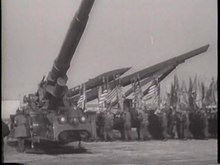
Note: hover the mouse pointer over images to get the description

As the automatically operated machine guns became more and more mature, Gatling guns were gradually forgotten, until the late 1940s. At that time, the speed of combat aircrafts became so high, so even most fast-firing conventional machine guns became too slow to achieve desirable number of hits during the very brief encounters. This spawned the famous "Project Vulcan", that was intended to develop a super-rapid firing weapon for US Air Forces. Project was handled by the General Electric Co. First tests were conducted with the late 19th century Gatlings, fitted with electrical drive instead of manually operated crank; this immediately resulted in the rate of fire of about 4 000 rounds per minute, which was very impressive (it must be noted, that such tests were first conducted in early 1890s, but lead to no practical results at that time - there were no need in the rate of fire of up to 3 000 RpM). Further development resulted in some experimental, electrically driven, .60 caliber machine guns with 6 barrels, and, in 1956, the 6-barreled 20mm T171 gun was officially adopted as the M61 aircraft gun. This gun could fire at the rate of 4 to 6 thousands rounds per minute. This achievement is possible due to the fact that gun has multiple barrels, and the rate of fire per one barrel is about 1 000 rounds per minute or even less, allowing them to not to overheat. M61 became the main aircraft gun for US AF, and also was used on M161 and M163 Vulcan ground anti-aircraft gun mounts. The navies also turned back to Gatlings with the Vulcan-Phalanx CIWS (Close-In Weapon System).


Usually, AH-1G "Cobra" carried one or two Miniguns in its chin turret, with the 2 or 4 thousands rounds of ammunition. The UH-1 could carry one or two (or even more) Miniguns on various mountings, with as much as 12 000 rounds of ammo available for "immediate delivery to enemy".

With the introduction of the 5.56mm ammo into the military service,
Americans attempted to scale the the Minigun further down, resulting in
the weapon, known as XM-214 Microgun. This little beast had 6 5.56mm
barrels, was electrically driven and could fire up to 10 000 rounds. But
the 5.56mm was way too weak for air-to-ground or ground-to-air
(anti-aircraft) applications - the key niches of the modern Gatling
systems. For the infantry, the Microgun had almost no use, being to
heavy, complicated and with too much rate of fire and recoil (recoil
force was up to 110 kg / 240 lbs at the full rate of fire). Infantry
simply does not needed an extremely rate of fire to deal with the enemy
infantry, and for AA use (where such high RoF makes sense), the 5.56mm
(.223mm) and 7.62mm (.308) ammo is way too weak.

Others than noted, US also developed a number of other Gatling-type designs chambered in .50BMG, 20mm,

25mm, and even 30mm (like the famous GAU-8/A "monster gun", shown at
left, mounted on the A10 Warthog attack planes). It also must be noted
that the USA was not the only country to exploit Gatling ideas. USSR
(and latter Russia) built several aircraft and AA guns and machine guns.
For helicopter use, they made a 4-barreled machine guns in 7.62mm and
12.7mm, and for aircrafts - 23mm and 30mm 6-barreled guns. Some
6-barreled 30mm Gatling type guns also used by Soviet and Russian navy
for shipborne AA installations, sometimes coupled with short-range AA
missiles.
Modern Gatling guns - pros and cons.
Key advantage of the modern, externally powered Gatling type guns, is
the extremely high rate of fire, usually 4 to 6 thousands of rounds per
minute (RPM), sometimes up to 10-12 thousands RPM. This rate of fire is
necessary to deal with the fast-moving targets, when the engagement time
is very short. Such targets are mostly aircrafts, or ground targets,
fired at from aircrafts. The downside of multi-barreled systems is they
relative complexity, heavy weight, and requirements for external power
(electrical, pressured air or hydraulics). There are few self-powered
(gas-operated) Gatling type guns, but they still are much bulkier and
heavier, than the conventional single-barreled guns. Another drawback of
the Gatling-type guns, which is essential for aerial combat, is that
the gun requires some time to get on to the full speed (rate of fire)
after the trigger is pressed. For the M61 Vulcan cannon, for example,
the "speed up" time is about 0.4 second or so.














